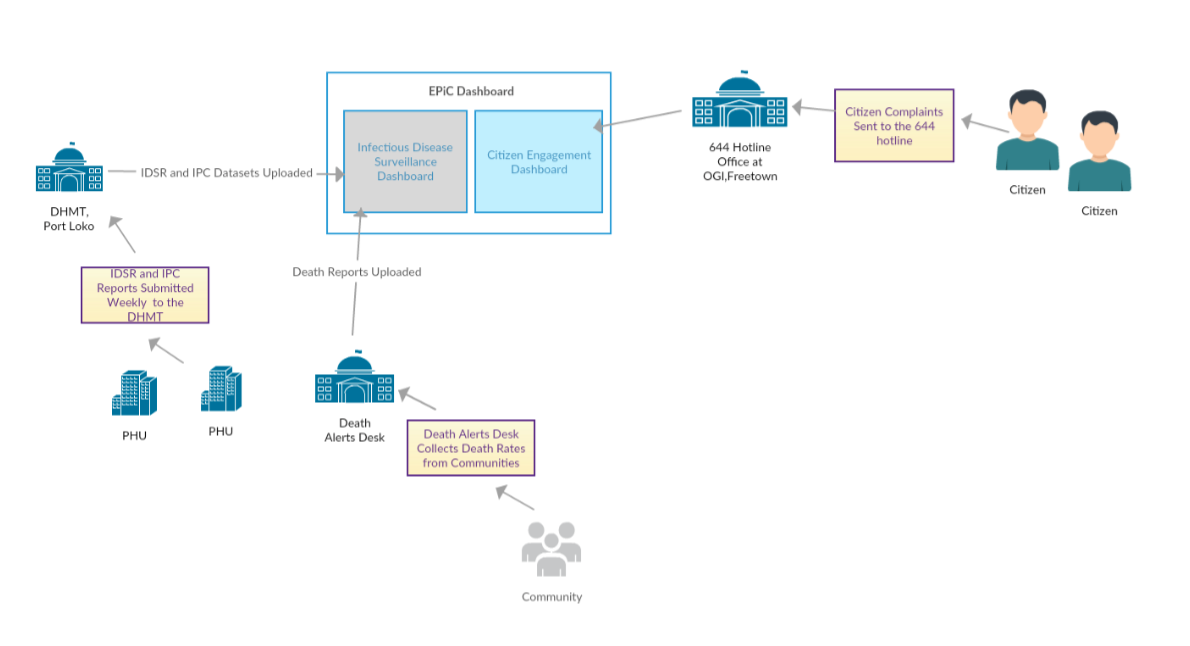IBM Research Africa
This post outlines the pilot and proof of concept study that was conducted for an infectious disease surveillance and community response system developed for all public health units in the district of Port Loko in Sierra Leone. The platform was developed by IBM Research Africa for the USAID Ebola Grant Challenge
This project was implemented while I was working as the Research and Developer lead at iDT Labs. For further information about this project please email info@idtlabs.xyz
The Context
The Ebola outbreak of 2014 in Sierra Leone highlighted how there was an absence of a proper mechanism between the Ministry of Health and Sanitation (MoHS) and its partner organizations for the sharing of important datasets that were imperative to understanding and fighting the spread of the epidemic. Instead, these datasets were often constrained in their silos, leading to extreme inefficiencies in the collection and analysis of critical health data, which had a negative impact that permeated downstream to the frontline response to the epidemic.
The Solution
The Epidemic Preparedness in Communities (EPiC) platform was built by IBM Research Africa to support heath sector stakeholders with data-driven tools for aiding evidence-based decision making during the post-Ebola recovery efforts in the healthcare sector in Sierra Leone. By leveraging a data-driven platform that provided strong data analytics and visualisation tools from a single, intuitive dashboard, the aim of EPiC was to help the MoHS, along with the other stakeholders and partners to utilise a data-driven process of tracking and preventing the spread of infectious diseases in their communities.
The platform aimed at enabling health administrators to quickly identify which health facilities and regions required urgent assistance using both formal health management records and community feedback.
The Scope of the Pilot
iDT Labs was contracted by IBM Research Africa to implement a one month proof of concept exercise at the offices of the district health medical team at Port Loko and the Open Government Initiative (OGI) at Freetown to conduct the following activities:
Map out the technical capacity for all organizations and users in the stakeholder group, including infrastructure (hardware and connectivity), systems (the current health information systems in place) and human resource capacity (technical abilities of potential users).
Provide training for the initial users of EPiC during the proof of concept phase
Map out the current workflows for the use of data in disease surveillance in Sierra Leone to form baseline for the Monitoring & Evaluation (M&E) assessment
The Methodology
The following officers from the DHMT at Port Loko participated in the pilot:
District medical officer
Data analysts supporting the district medical officer
Infectious disease and health surveillance officers
Monitoring and evaluation officers
The purpose of the pilot training at the DHMT was to help participants understand the system and how data driven surveillance and interventions could lead to substantial efficiency gains. The training was also divided into three main portions that were designed to transition the users through the following three stages

Data Flow of the System
The following diagrammatic representation mapped out how the existing data flows would ideally integrate with the disease surveillance and community response dashboards of EPiC.

Key Insights From the Pilot
The following were they key insights that were gained from the pilot, which are relevant for any data driven initiative that is aimed at improving the service delivery of a critical public sector entity in a post conflict economy such as that of Sierra Leone.
1.Data visualization and intelligence is the end product of a value chain that involves several pre-requisite activities, and any data visualization tool should support this entire value chain
Although the data intelligence and visualisation functionalities related to disease surveillance would greatly help any under funded national health unit, data visualisation is in fact a minor component in the chain of activities carried out by surveillance officers. The system should have provided the users with functionalities for directly uploading, verifying and sharing the raw data that was used by the platform to generate intelligence and reports.
2.A strong stakeholder engagement strategy is critical for the successful adoption of any technological intervention in the public sector
For the successful, eventual roll out of any national disease surveillance system , stakeholder buy-in is of utmost importance. Over the course of the trainings conducted at the DHMT, low priority was afforded to the exercise by the top management of the DHMT, with individuals dedicated to the exercise being low-level employees with limited understanding of the entire value chain of infectious disease surveillance that EPIC aimed to support.Given the alarming rate of failed technological interventions in post conflict countries such as Sierra Leone, effective user adoption is by far the biggest risk to the long term survival of the platform.
3.Downloadable, printable copies of reports is important in a “paper based” low digital literacy context like Sierra Leone
Owing to the “paper based” culture that is prevalent across governmental departments in developing countries, any system must allow for easy printing of all reports generated by the users.
